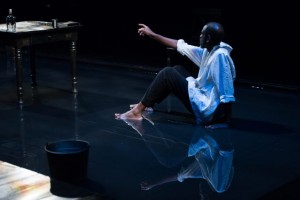Sloppy pen/man/ship at CATF
Theater Reviews Page | Previous Theater Review | Next Theater Review
Sloppy pen/man/ship at CATF
Posted on BroadwayWorld.com July 14, 2016
Playwright Christina Anderson returns to the Contemporary American Theater Festival in Shepherdstown, West Virginia with a new play,pen/man/ship. I was not an admirer of her play The Ashes Under Gait City, produced at the Festival two years ago, being taken aback by its internal inconsistencies, its lack of historicity, its unnecessary improbabilities, and its general lack of craft. I allowed that there was a strong element of just-among-African-Americans discussion implicit in it which may have bypassed my ken and hence my critical faculties, but I could only speak from what I understood.
The good news is that pen/man/ship is both more accessible to general audiences and better written. The bad news is that it still needs a lot of work.
The premise is ahistorical: an 1896 ship chartered by a U.S. African American, with a black crew, sailing from America to Liberia, with an eye to undertaking an activity there of a sort which there is no record I can find of anyone having undertaken. At a crisis in the middle of the ocean, the crew lowers the sails of the ship and unbelievably leaves it bereft of wind power for at least 22 days. Taking down all the sails, what sailors call “bare poles,” is acknowledged to be an extremely risky maneuver, and not one any sane group of sailors would ordinarily undertake except under extreme storm conditions, especially for such an extended period. Anderson claims to research her plays, but I saw scant evidence of this, down to the very language. She cannot hear an obvious anachronism (“subpar” did not appear in the language as a synonym for “inferior” until many years later). She makes a mistake in describing her central character’s occupation; he is said to be a “land surveyor,” which she seems to think means a land appraiser, a meaning the phrase does not bear today and did not bear in that era.
So out of touch with historical realism is the play, other theatergoers with whom I discussed it suggested the story should be viewed as a hallucination or fantasy of the “land surveyor.” And perhaps that is what was meant; I cannot tell.
Just to make it all more confusing, most of the set of the play (by Kris Stone) is situated in an inch or so of water. The characters walk around barefoot in it, fall prostrate in it, and never seem by their actions to acknowledge it. The water is not called for by the script, and plays no clearly evident role in the action. When characters are standing in the water, we understand them to be in a cabin of this ship, but since the character who occupies the cabin we are supposed to be in most of the time is the charterer of the expedition, a man who regards himself as superior to all the other souls on the vessel, one would expect that, were the water to be taken literally, he would have selected a cabin from which any bilgewater was drained. If the water is meant to symbolize the sea, there are other problems. It is not my intent to belabor this point; let me say simply that there is no clear sense to the standing water.
I said at the outset that pen/man/ship is accessible, especially by comparison with Gait City. And it is. We can understand that Charles, the “land surveyor” and ship-charterer (Brian D. Coats), is a black man who believes himself superior to all the black people who surround him. He has internalized the view held by Jim Crow America of African Americans as the inferior “other,” but in order to entertain that view he necessarily has mentally set himself apart. Anderson’s remarks in the program suggest Charles is an exemplar of America’s notion of exceptionalism.
Of course it is all a charade. Charles is an alcoholic and an emotionally abusive father, his hidden project is morally objectionable despite his outward religiosity, and he either commits murder in the course of the play or abets someone else’s crime. Under the tutelage of Ruby (Margaret Ivey) the sailors come to recognize the true dimensions of the situation, and contrive to force Charles to confess his crimes. The spectacle of a man with these specific hypocrisies being deprived of control over his circumstances is accessible as a dramatic action and as a consideration of the underlying racial and social issues. And it works dramatically.
It would just work better if Anderson would not make up such an outlandish situation for the action. We get it that this is a reversal of the Middle Passage, but why are we doing that? Is it to depict a threat by American values to Liberia? If so, why choose as the vehicle for that threat a project that never happened, borne back to Liberia on a charter that seems never to have been chartered? If there is an implicit indictment of the racism beneath the mask of neocolonialism, surely there are more factual ways to do it. (See, e.g. Kwame Kwei-Armah‘s Beneatha’s Place, which does a great deal with the way that Americans and other Westerners helped screw up newly liberated West Africa in the middle of the previous century.)
I would urge Anderson to strip the play down to the studs and rebuild it. I think there is a gripping play here, but it urgently needs to be set somewhere else and carefully researched. As the play now stands, I must say regretfully that if there is one show to miss at this year’s Festival, this is the one.
Copyright (c) Jack L. B. Gohn, except for production photo (photo credit Seth Freeman)
Theater Reviews Page | Previous Theater Review | Next Theater Review
